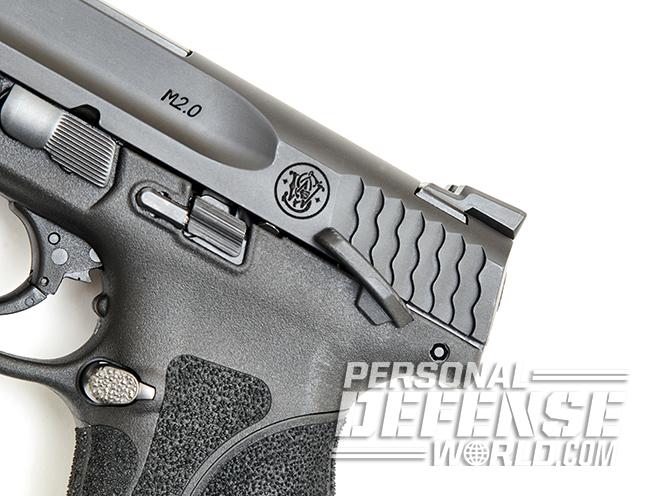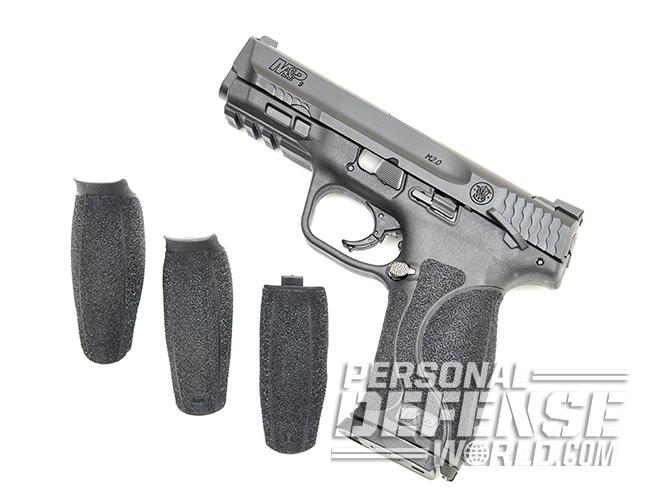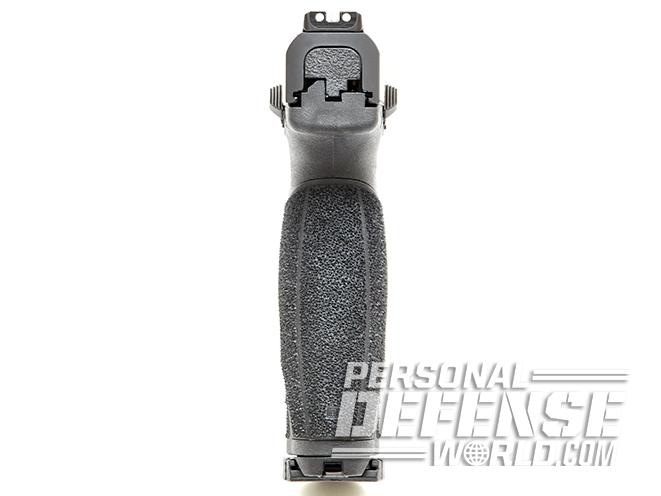After the latest announcement from Smith & Wesson, I can’t help but to remember a quote from Michael Corleone (Al Pacino) in The Godfather Part III: “Just when I thought I was out, they pull me back in!”
This is where I should explain that I have suffered an addiction for Smith & Wesson handguns for well over four decades. My first centerfire handgun was a S&W Model 10 Military & Police, and that medium-frame revolver was soon sitting next to a Model 28 Highway Patrolman in .357 Magnum. It was the Model 28 that got me into shooting Handgun Silhouette matches, which soon justified my need for greater power and the Model 29 in .44 Magnum.
I could continue recounting the path of my downfall, but I will abstain since I thought I had my “condition” under control. I had found help by attending Dianne Feinstein’s 10-Step Gun Control Program, and I assure you it will turn anyone into a mindless and docile sheep. Besides, it had only been six months since I purchased a Performance-Center-enhanced M&P Shield, and the “new” has yet to wear off.
Advertisement — Continue Reading Below
Of course, right about the time I start to feel proud of myself, Smith & Wesson pulls me back in with the release of the new M&P M2.0 series of pistols.
It has been over a decade since Smith & Wesson resurrected the “Military & Police” moniker with the introduction of a new series of full-sized, polymer-framed handguns, and at the time I was in my retro stage and collecting the company’s third-generation semi-autos. My total exposure to the original M&P pistol may be somewhat limited, but I found it to be rather acceptable. Most would agree that this totally new design was a vast improvement over the Sigma series of handguns debuted in the mid-1990s. Now, due to my newfound acceptance of “plastic” handguns fostered by the Shield, and S&W’s ploy of borrowing the “2.0” label from the software industry, I found my curiosity rising. Fortunately, Smith & Wesson has a support group for people in my condition and rapidly sent out a sample for review.
Fully Evolved M2.0

Many will be familiar with the original polymer-framed M&P series, which will now probably go down in history as the “1.0.” Introduced in 2005, the M&P was considered a full-sized duty pistol for law enforcement and civilian use. It was also S&W’s first good answer to draw away a share of the market from the Glock pistols. The M&P appeared to be one of the first pistols of the “plastic” age to take into account the lost art of ergonomics. However, in the eyes of some, mainly S&W engineers, this pistol was not perfect. It is the efforts to make subtle refinements to the M&P design that has led to the introduction of the M&P M2.0.
Advertisement — Continue Reading Below
- RELATED STORY: Classic Snubbies – 3 Iconic S&W J-Frame Revolvers
Just opening the box will show you the first change to the design. The M&P normally came with three interchangeable palm-swell grip inserts to allow users to adapt the grip size to their individual hands. That number has been increased to four with the addition of a medium/large unit to go along with the standard small, medium and large inserts.

If you look closer you might notice one of the more significant changes to the M2.0. The structural stainless steel insert in the polymer frame has been extended out to the end of the dust cover. This change was incorporated to decrease the flex in the frame during firing, but only an engineer could come up with this modification. I doubt the average person would ever realize there was any flex to begin with. The result: By decreasing the flex, you also decrease the felt recoil, and that is one thing the average shooter will notice.
Keeping with this train of thought, the frame profile has been modified slightly to provide a higher grip on the pistol. This lowers the difference between the centerline of the bore and the shooter’s grip, which decreases the muzzle rise and the time needed to recover from the recoil for a second shot. When comparing the new to the old, you might notice the M2.0 no longer has the extended beavertail at the back of the frame. To be blunt, it isn’t needed, and in my opinion the deletion is an improvement in the overall profile of the handgun.
Advertisement — Continue Reading Below

The trigger on the M2.0 is one change everyone will notice. The trigger system is lighter, and the majority of the mushiness found in striker-fired handguns has been eliminated. The new trigger has about 0.38 inches of free travel before it comes to a stop. Then 0.13 inches of travel with about a 5.25-pound pull fires the gun. There is a trigger stop molded into the frame, and the new trigger has a quick and audible reset. Overall, this trigger is an improvement over the original M&P’s, and it feels better than any of the other striker-fired handguns I’ve tested.
A feature I truly like about my test gun is that it came with an ambidextrous thumb safety. The M2.0 can be supplied with or without this safety, but I strongly suggest this feature. I would challenge anyone to prove that a nanosecond of speed is lost by its addition once the shooter is used to sweeping it down during the draw. Think about it: You may never need an airbag in your car, but it is pure gold should a need arise. While we are speaking of safety, it should be noted that the M2.0 pistol does not have a magazine disconnect and will fire with the magazine removed. This is noted along the right side of the slide just to prove that corporate lawyers are still staying active.
As soon as you pick up this pistol, you’ll notice the new texturing applied to the grip. It feels similar to a very fine grade of sandpaper. There is no doubt that this texturing will provide a secure grip under any conditions, but I’ll talk more about that soon enough.
Advertisement — Continue Reading Below
While not new, it should be mentioned that the M2.0 is a truly ambidextrous handgun. The magazine release comes from the factory on the wrong side, but it can be switched for left-handed shooters. The slide release is also on both sides of the gun, which allows me to forgo my normal rant concerning the mistreatment of lefties like me.
Something that has not changed is the excellent finish on S&W handguns. The slide has a tough, corrosion-resistant Armornite finish, and the M2.0 is available in black or Flat Dark Earth.
On The Firing Line

One thing that even Dianne Feinstein can’t change is my urge to carry any new firearm to my local shooting range. It is one thing to look at a new handgun, but perceptions can change quickly once you try it out on the firing line.
Advertisement — Continue Reading Below
Collecting gear for the first range session was more about switching holsters and magazines than anything else. I had tested another 9mm just a week prior, and the ammunition was still in my range bag. Sig Sauer’s 124-grain JHPs, Hornady’s 115 grain FTXs and Winchester’s 147-grain JHPs cover most of the weight variations for the 9mm and have always given me good accuracy results. If a 9mm handgun won’t work well with one of these loads, there is a good chance it has problems.
It should be noted that even with the changes made to the M2.0; this pistol will use the same magazines and holsters as use the original M&P. This may not seem too important if you don’t already own an M&P, but it is a major cost savings for anyone upgrading from the original platform.
- RELATED STORY: Smith & Wesson’s Performance Center M&P R8 Pistol
It had only been a couple of years since I had attended a function held by BlackHawk, and during that trip we were using S&W M&P pistols with several BlackHawk holsters. Yes, they even made sure they had left-handed models for those of us so blessed. I did a quick double-check and, sure enough, these holsters were a perfect fit for my test sample M&P9 M2.0. I added a SERPA concealment model as well as a leather and plastic hybrid, the GripBreak, to my range bag.
Advertisement — Continue Reading Below
As is my normal practice, the range session started with accuracy testing at 25 yards. All three loads performed well, and at this distance there was very little change in the point of impact between the three loads. I did note that all three had a tendency to hit a bit right of center, but over the years I have found that most of that can be blamed on me rather than the pistol. Once I got off of the bench and shot off-hand, most hits were basically dead-center with an inch or two variation due to the difference in velocity and bullet weight. The majority of the five-shot groups ranged between 2.25 and 3.25 inches.
Once I finished with the accuracy testing, I shot an array of “leftovers.” Over time, I usual end up with a selection of ammunition of various weights, bullet styles and manufacturers. After each range session, if I have a few shots remaining, I’ll just throw them into a box and save them for moments like this. Various magazines were randomly loaded with this mix of cartridges and then fired at a 12-inch square plate just to check the function of the handgun. One of the main reasons I have been fond of Smith & Wesson handguns is that their reliability has always been outstanding. To this point, the M&P9 M2.0 did not experience a single malfunction or failure to fire.
Range Drills

Advertisement — Continue Reading Below
The initial range session was followed a few days later with a little more relaxed shooting at a selection of 6-inch steel plates at distances of 15 to 20 yards. That afternoon took an entirely different approach than the first, and I fired all of the shots off-hand after drawing from one of the BlackHawk holsters. I would draw and fire two or three shots at the plates before reholstering. The object was not speed as much as building muscle memory.
The first thing I discovered was that you need to find one style of holster and stick with it. Both of the BlackHawk holsters worked well, but they have different forms of retention. The SERPA is released by the trigger finger while the GripBreak is released with the thumb. It is next to impossible to build muscle memory when you are switching from one to the other. I finally concentrated on the SERPA since I have this holster to fit several of my other handguns. But I did like the GripBreak! I also discovered that the medium grip insert worked best for me. It kept the bore of the barrel parallel with my forearm without having to bend my wrist.
Smith & Wesson’s engineers can take a bow. Their decision to stay with the 18-degree grip angle proved to be perfect. The change in grip texturing also worked well without any undue discomfort on my tender hands.
Advertisement — Continue Reading Below
Making The Grade

If you liked the original M&P series, you should really enjoy the M2.0. In my humble opinion, every modification to the original has been an improvement. The one aspect not mentioned is that the price has stayed very reasonable. I can only wonder if S&W will be looking at changing the various other members of the M&P family.
- RELATED STORY: Smith & Wesson’s M&P22 Compact Suppressor Pistol
It is about time that I admit to myself that there is very little I can do about my addiction, and I might as well embrace it. This new M&P9 M2.0 seems like a good place to start.
For more information, visit smith-wesson.com.
This article was originally published in ‘Concealed Carry Handguns’ Spring 2017. To subscribe, visit outdoorgroupstore.com.





































